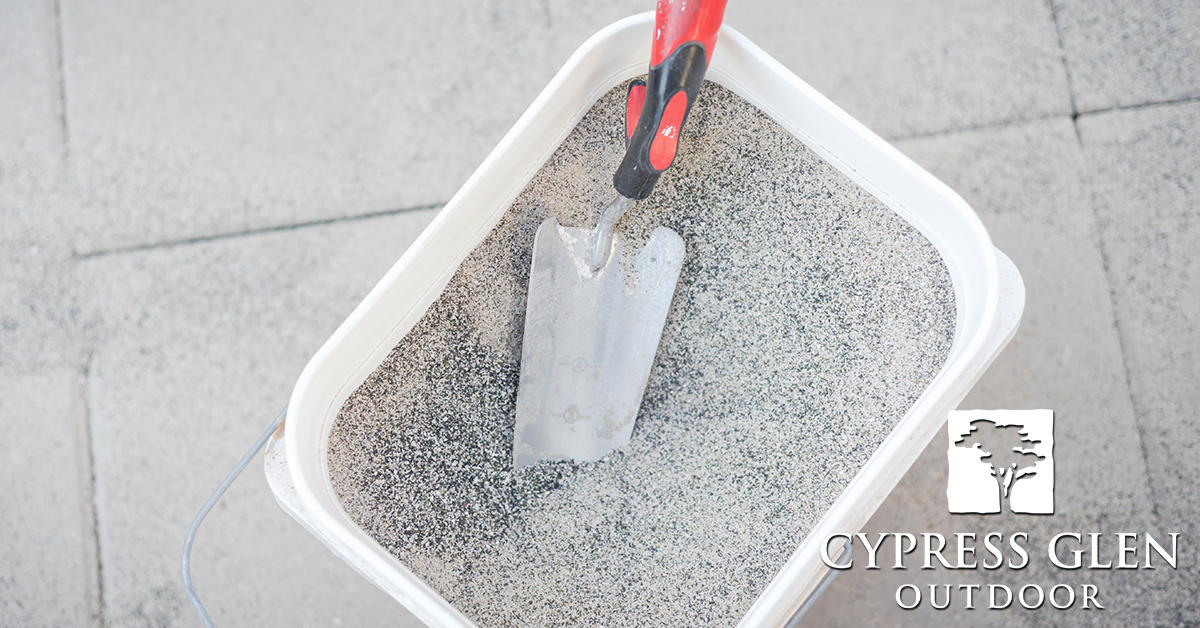

Outdoor spaces often include paver patios, pool decks, or stone driveways, but proper care, including patio sealing, is essential. Properly cared for and maintained patio pavers can last a lifetime. And with the investment into your outdoor space, why wouldn’t you want to keep the initial visual beauty?
Why Seal My Patio Pavers
Extending the lifespan of your patio pavers includes sealing them. While pavers look stunning and are intended to withstand the elements of the outdoors, keeping them looking and functioning with their best sealant is necessary.
Patio Paver Color Preservation
UV rays cause pavers to fade over time. Although the patio pavers remain strong, the sun’s UV rays fade their pigment, stripping their vibrancy and leaving them dull. Sealing the patio pavers preserves the original color you chose to keep them looking new.
Not only can patio sealing preserve the original color of the pavers, but it can also enhance it! Patio sealant acts as varnish does to wood but for stone! A sealant can pull out the natural contrast in the stone, making it appear brighter. Some sealers can even give the pavers the “wet look” that might appeal to you.
Additionally, and maybe most importantly, patio sealing makes the pavers less porous. This limits the amount of oil, dirt, or other unwanted substances absorbed into the pavers. Less staining is always ideal for any surface, including pavers! Plus, sealing your concrete pavers makes spill cleanup easier.
Stabilizing Joints
When applied, the sealant also stabilizes the joints between pavers. If you have sand or loose material between your pavers, it will shift over time because of their outdoor exposure to wind and rain. The goal is to keep joint sand between the pavers out of the pool.
When To Seal Pavers
With Cambridge Armortek pavers, we recommend waiting one year before sealing to allow the naturally occurring, white, dusty-looking buildup, known as efflorescence, to escape from the paving stones. This is due to the unpredictability of efflorescence’s bleeding process.
Before sealing any surface, you must ensure there is no efflorescence in the pavers. Efflorescence is the natural process that occurs in all cement-based products and many other paving products. Over time, the condition will correct itself with exposure to the elements.
How To Seal Patio Pavers
Patio sealing is your personal choice based on aesthetic preferences. Although not necessary, it can benefit your pavers’ longevity. Before sealing, we clean your paving stones with an efflorescence cleaner.
For best results, we ensure the pavers are dry and there is no predicted rain in the next 24 hours. We remove all furniture, debris, existing stains, and weeds growing between cracks. After clearing the area, we clean and apply a sealant according to industry guidelines.
If your paver patio needs some love, please contact us at Cypress Glen Outdoors. We’re here to bring your patio back to life and protect it in the future! We can enhance and protect your pavers for you… call today!


Polymeric sand is a fine sand mixture combined with other additives that, when mixed with water, form a strong binding agent. Polymeric sand application fills the spaces between pavers, tiles, or other outdoor stones. This type of sand is often used as the last step of a landscape or paving project to create a surface that will not shift over time.
Why Use Polymeric Sand
Polymeric sand application enhances the tried-and-true process of using sand between stones! The polymeric sand binding agents help lock the pavers together, improving durability. This sand gives your installation a longer-lasting strength while keeping out unwanted plants and pests. The sand comes in various colors, so you don’t have to sacrifice appearance for performance.
Benefits of Polymeric Sand Application
Once sealed, unlike traditional sand, polymeric sand will not wash away with heavy rains. The binding additives in polymeric sand reduce the amount of water that can access the sand between pavers, reducing washout. This process keeps the base foundation under the created surface sturdy and intact.
A polymeric sand application also deters weeds and pests. As anyone knows, weeds are amazingly resilient and try to grow almost anywhere. While polymeric sand can’t guarantee that weeds will never grow between pavers, it will help since ordinary sand is much more inviting.
Like weeds, ants love to make themselves at home in your space. Polymeric sand is ant-resistant, making it difficult for them to settle between your pavers.
Mistakes When Using Polymeric Sand
While the polymeric sand application process may seem relatively straightforward, it has many opportunities to go awry. If you do not remove the excess sand before setting it with water, any excess will harden on top of the pavers and cause discoloration.
Water needs to be able to drain from the sand during the curing process, which can take weeks. If your patio is not installed at a level or has a drainage incline, the curing will not happen properly. For larger paver projects, installers may need to drill small weeping holes into the sand every few feet to help drainage aid in curing.
The installer needs to strike a balance between not overfilling or underfilling the joints. Excess sand will be hard to remove, and underfilling the joints will weaken them, creating an unappealing look.
The same delicate balance is necessary for the watering seal step. You must add enough water to activate all the polymeric sand layers fully. However, too little watering will only activate the very top of the sand.
Incorrectly installed pavers will move around and impact the polymeric sand in the joints. The sand can slightly flex to accommodate micro-movements, but it cannot handle more significant movements of unsecured pavers caused by poor installation. Though this type of sand rarely, if ever, cracks, large movements of unsecured pavers may cause it to do so.
Polymeric Sand Installation
A professional should do the application for the best results when using polymeric sand. Not only that, but this polymeric sand’s success depends on the steps’ success beforehand: properly installing pavers and paver sand. Knowing now that filling narrow joints with the proper drainage can be challenging, let a professional can best handle your oversized patio or walkway installation of pavers. Let Cypress Glen Outdoor build the backyard you’ve been dreaming of!

Our Latest Reviews
High Quality Pavers and Decking








